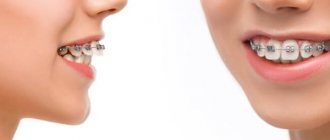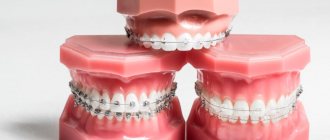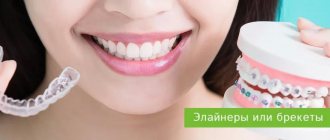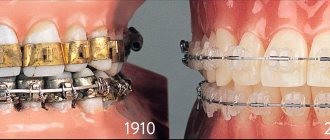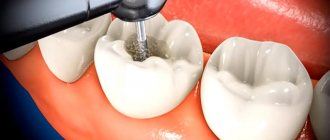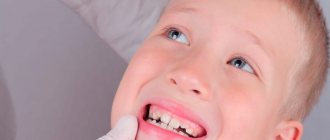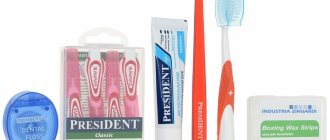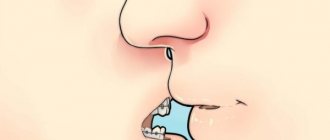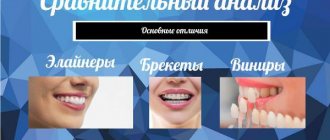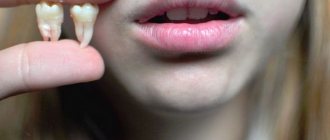What can you eat in the first days after getting braces?
Almost immediately after fixing the brace system in the oral cavity, the patient will experience unpleasant sensations associated with increased pressure on the dentition. Chewing may cause severe pain. Therefore, experts recommend in the first days to give preference to soft and strained food. The following products and dishes are optimal:
- liquid porridge;
- soups;
- cottage cheese;
- kefir;
- yoghurts;
- jelly;
- vegetable puree, etc.
Possible breakdowns - does the wearing period increase?
Sometimes you may encounter structural elements breaking and peeling off. The reason for this is sudden and excessive loads occurring:
- there is a shortage of space in the dentition or pronounced crowding of molars at the very beginning of bite correction - even minor movements of the teeth can create tension;
- careless use of cleaning accessories for oral care;
- violation of the diet, consumption of hard foods, and, as a result, damage to the system.
Of course, in this case, you need to consult a doctor immediately, since only in a specialized clinic can the detached element be fixed.
Remember that the entire system works as a single whole, and therefore the breakdown of even one element can affect how long you wear braces, since the functioning of the entire device is disrupted.
What food is preferred throughout treatment?
When the patient gets used to the brace system, you can gradually expand the diet. The following is a list of products that will not cause any harm to the orthodontic structure:
- soups;
- yoghurts, kefir;
- soft cheeses;
- soft chicken fillet, thin sliced meat;
- fish, crab sticks;
- eggs;
- pasta;
- boiled rice;
- mashed potatoes;
- soft pastries, pancakes, bread crumbs;
- applesauce;
- bananas;
- jelly;
- milkshakes;
- vegetable caviar, stewed vegetables;
- cutlets, pureed meat.
The list of recommended products is quite large. It is important to understand that you should not bite hard food with your teeth. But if, for example, you grate an apple or carrot, you can eat them without fear for the safety of your braces.
Good to know. Braces are the best “nutritionist”. By adhering to some dietary restrictions, patients will receive not only straight and beautiful teeth, but also a slender figure.
Can braces come off?
The system is securely, but not tightly, attached to a special glue, and when biting on some products, its elements may come off. This most often occurs when eating solid foods. If one or more braces come off, you need to consult a doctor.
You can install braces at the Saint-Dent Clinic in Moscow. Qualified dentists of all specializations work here. The clinic uses advanced technologies and modern materials to treat patients. The contact page is located here Contacts. Patients can find out the cost of dental services here Prices for dental services.
Hard and sticky food
Eating solid foods leads to damage to the arch structure and displacement of the dentition. This also often causes locks to come unstuck. The following products are completely prohibited:
- nuts;
- crackers;
- seeds;
- hard treats (lollipops, caramels);
- hard fruits and vegetables.
Sticky and viscous products heavily contaminate the teeth and components of the orthodontic apparatus and are quite difficult to remove. They also cause the development of caries and inflammatory processes in the gums. You should refuse:
- soft sticky candies;
- chips;
- buns
- corn sticks and flakes;
- cheese;
- chewing gum.
Hot and cold food
Even people with absolutely healthy teeth should not expose their teeth to sudden temperature changes. And if a person wears braces, eating too hot and cold food is completely prohibited. This is especially true for bracket systems, which contain thermoactive elements that can change their properties under the influence of temperature.
You should avoid the following foods:
- cold ice cream and desserts;
- hot soup;
- scalding coffee, tea and other drinks.
In any case, braces mean discomfort when eating. Do you really need braces as your doctor advises?
After all, the main issue lies not in diction, and not in problems with brushing your teeth. And the question is - are you ready to carry this pile of iron in the form of metal and ceramic braces in your mouth for the entire duration of treatment (a year or two)? Rub your tongue against them, polish them until they shine, constantly eliminating pieces of food? Braces when eating are uncomfortable and not aesthetically pleasing. Consider treatment with aligners. There will be no problems at all when eating - food will not get stuck in them and your breath will not smell bad. The Star Smile company operates in more than 70 cities of Russia and will be able to offer you competent consultation with an orthodontist in your city. And the prices will pleasantly surprise you, because Star Smile has the lowest prices with excellent quality of treatment. Take the first step towards comfortable treatment.
Drinking alcohol and smoking during braces treatment
Drinking alcoholic beverages is undesirable, as they contain large amounts of sugar, which has a destructive effect on teeth. After drinking even a small amount of alcohol, a wearer of braces will have to brush their teeth. If this is not done, in the future you will have to deal with caries and inflammatory processes of the gums. In addition, alcohol leads to dry mouth. And this entails the occurrence of wounds and ulcers.
Smoking can spoil the appearance of the structure by staining some elements. It also leads to staining of tooth enamel, but in the places where braces are attached, the enamel will remain the same color. As a result, after removing the system, contrasting stains will be visible on the teeth. It is very difficult to even out the color, since nicotine is difficult to lighten. If you cannot completely quit smoking, you must at least reduce the number of cigarettes you smoke.
Simplifying life or care features
Considering that the period of wearing braces is not short, certain questions arise that relate to eating habits, adherence to specific diets, as well as oral care.
It doesn’t matter what model of orthodontic appliance you wear, you need to strictly monitor your oral hygiene. You can use special brushes, this should be done after every meal. You will also need threads with a stiff end and pipe cleaners. As for cleansing tablets and special disinfectant compounds, it is better to discuss their use with your doctor.
You will have to give up foods that can damage the system - nuts, crackers, too hard food. Vegetables, fruits and meat should be cut into pieces; do not try to bite off a whole apple or pear, so as not to damage the retention apparatus - this can affect the wearing time.
You should avoid sweet carbonated drinks, as they have a detrimental effect on the enamel of molars.
Read more here: How to properly care for braces
Advice from professionals
- If the orthodontist has given the patient specific recommendations regarding what foods should absolutely not be consumed during treatment, they should be strictly followed.
- You can only chew soft foods with your front teeth. It is better to chew other foods with your back teeth.
- If the patient feels hungry and has tooth pain at the same time, it is worth drinking a cool smoothie or milkshake. The cold will ease the pain, and the drink will reduce the feeling of hunger.
- In the first days after installing the braces system, you should not touch your lower teeth to your upper teeth, as this can cause pain.
Teeth hurt from braces: 3 main reasons:
There are three main reasons why orthodontic devices cause jaw pain. This is the effect of the arc on units and rubbing of the oral mucosa by the elements of the system.
- Arc pressure.
Braces systems move teeth using the main element – a power arc. This is a thin metal wire with shape memory that puts pressure on the tooth and moves it to the physiologically correct place.
The remaining details - clasps, ligatures, rings - are auxiliary. Their main function is to fix and hold the power wire.
It is the movement of the roots that causes the most intense pain sensations. The teeth literally make their way into the bone and soft structures. The process is accompanied by resorption (rarefaction) of tissues on the one hand and their compaction on the other. That's why pain occurs.
- Irritation of the oral mucosa after installation of braces
The main part in braces that injures the mucous membrane is the clasps. These are special staples. They are attached to the enamel and equipped with grooves in which the arc is fixed.
The elements protrude by several millimeters, and their edges, no matter how hard the manufacturers try, cannot be perfectly smooth. Therefore, the tongue, inner lips and cheeks often chafe.
The sensations are pronounced, but the “brace wearer” quickly learns to handle the parts carefully, and the mucous membrane becomes a little keratinized (thickened) over time. And the discomfort goes away.
- Excessive pressure.
If the orthodontist has tightened the wire too tightly, the units will experience increased stress.
- Injury from the edges of the arc.
It is usually folded behind the last molars. But if this is not done, the wire is too long or has come out of the groove, it will scratch the cheeks. The same thing happens when the device breaks down. Breaking the ligature and peeling off the staples violate the integrity of the structure, and its parts begin to tear apart the oral cavity.
Pain and discomfort when installing braces:
Severe pain does not occur during fixation of the structure. The procedure lasts 2 – 3 hours. During this procedure, the orthodontist positions the clasps on the enamel with a special adhesive (bond), fixes the wire and activates the device. All a person will feel is a small onslaught.
Discomfort may be associated with:
- staying in one position for a long time with your mouth open - this causes the muscles of the face, neck and back to become numb;
- installed mouth dilator - it is needed to get a good view and trouble-free access, but it can rub the corners of the lips and lead to their drying out;
- activation of braces - immediately after it the bite begins to align, pressure arises.
The sensations are not very pronounced, you just have to endure them. The only thing that can be done is to lubricate the lips and the area around them with a rich cream and hygienic lipstick before the manipulation. This will prevent the patient from excessive drying of the skin and the appearance of cracks on it.
The most difficult period is the first week, how to relieve pain?
The most intense pain is typical after installing a brace system and when changing the archwire. This is a normal condition that will go away by the end of the week. in the first days, eat only semi-liquid food at room temperature - juices, yoghurts, jelly, baby purees;
- take an anesthetic or non-steroidal anti-inflammatory drug - Ibuprofen, Nise, Ketonal, Paracetamol;
- use local anesterizing drugs with lidocaine - “Cholisal gel”, “Dentinox”, “Kamistad”;
- eat ice cream or drink cool water - the cold will reduce the intensity of sensations;
- if the wire damages the cheek, you must ask the dentist to cut it and bend it;
- when discomfort is caused by excess pressure, you need to consult a doctor to relieve it;
- If it breaks down, visit the orthodontist - he will replace the parts and adjust the system.
If the pain is too intense, radiating to the head and neck, you should urgently visit the clinic. The specialist will identify and eliminate the cause.
The last stage of wearing braces is painless!
At the end of the bite correction, nothing should hurt. The new smile is almost ready, and the last months of wearing it are needed so that the bone structures have time to finally form. Removing braces is absolutely painless. The only thing that may occur is hyperesthesia - excessive sensitivity of the enamel. It develops due to microcracks that appear when wearing the device.
To relieve hyperesthesia, remineralization and fluoridation are performed.
